Welcome to Subscribe On Youtube
Formatted question description: https://leetcode.ca/all/1516.html
1516. Move Sub-Tree of N-Ary Tree
Level
Hard
Description
Given the root of an N-ary tree of unique values, and two nodes of the tree p and q.
You should move the subtree of the node p to become a direct child of node q. If p is already a direct child of q, don’t change anything. Node p must be the last child in the children list of node q.
Return the root of the tree after adjusting it.
There are 3 cases for nodes p and q:
- Node
qis in the sub-tree of nodep. - Node
pis in the sub-tree of nodeq. - Neither node
pis in the sub-tree of nodeqnor nodeqis in the sub-tree of nodep.
In cases 2 and 3, you just need to move p (with its sub-tree) to be a child of q, but in case 1 the tree may be disconnected, thus you need to reconnect the tree again. Please read the examples carefully before solving this problem.
Nary-Tree input serialization is represented in their level order traversal, each group of children is separated by the null value (See examples).
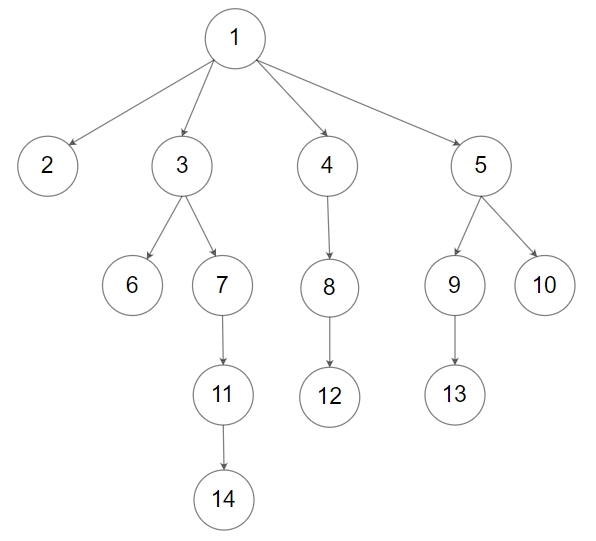
For example, the above tree is serialized as [1,null,2,3,4,5,null,null,6,7,null,8,null,9,10,null,null,11,null,12,null,13,null,null,14].
Example 1:
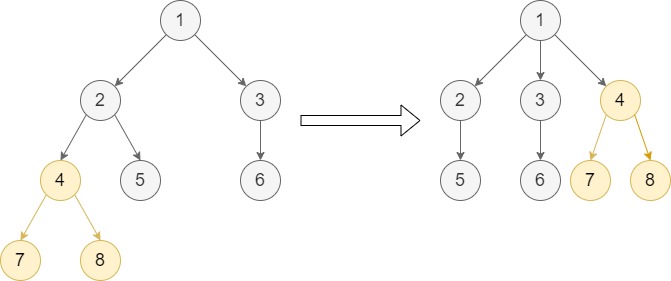
Input: root = [1,null,2,3,null,4,5,null,6,null,7,8], p = 4, q = 1
Output: [1,null,2,3,4,null,5,null,6,null,7,8]
Explanation: This example follows the second case as node p is in the sub-tree of node q. We move node p with its sub-tree to be a direct child of node q.
Notice that node 4 is the last child of node 1.
Example 2:
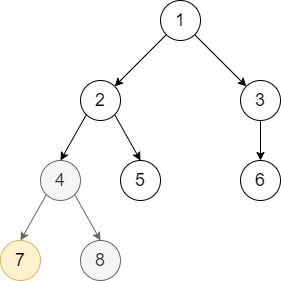
Input: root = [1,null,2,3,null,4,5,null,6,null,7,8], p = 7, q = 4
Output: [1,null,2,3,null,4,5,null,6,null,7,8]
Explanation: Node 7 is already a direct child of node 4. We don’t change anything.
Example 3:
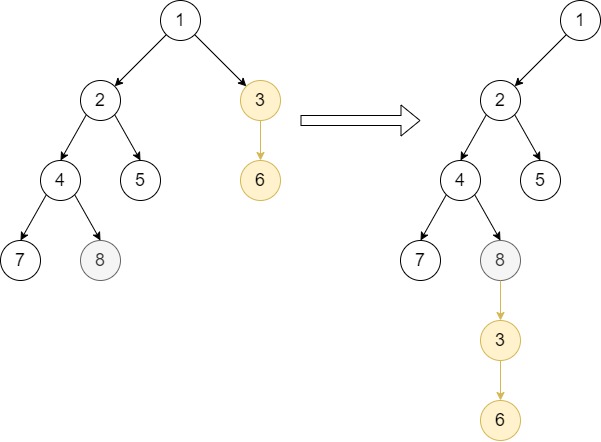
Input: root = [1,null,2,3,null,4,5,null,6,null,7,8], p = 3, q = 8
Output: [1,null,2,null,4,5,null,7,8,null,null,null,3,null,6]
Explanation: This example follows case 3 because node p is not in the sub-tree of node q and vice-versa. We can move node 3 with its sub-tree and make it as node 8’s child.
Example 4:
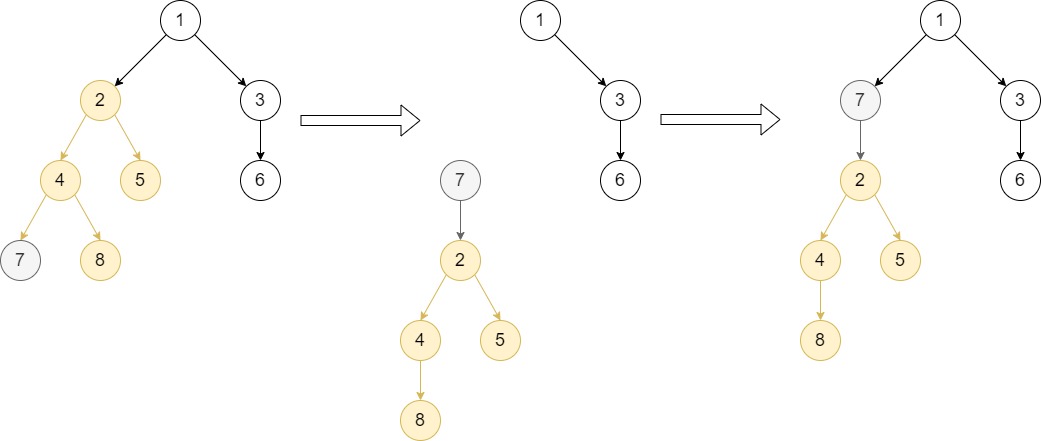
Input: root = [1,null,2,3,null,4,5,null,6,null,7,8], p = 2, q = 7
Output: [1,null,7,3,null,2,null,6,null,4,5,null,null,8]
Explanation: Node q is in the sub-tree of node p, so this is case 1.
The first step, we move node p (with all of its sub-tree except for node q) and add it as a child to node q.
Then we will see that the tree is disconnected, you need to reconnect node q to replace node p as shown.
Example 5:

Input: root = [1,null,2,3,null,4,5,null,6,null,7,8], p = 1, q = 2
Output: [2,null,4,5,1,null,7,8,null,null,3,null,null,null,6]
Explanation: Node q is in the sub-tree of node p, so this is case 1. The first step, we move node p (with all of its sub-tree except for node q) and add it as a child to node q.
As node p was the root of the tree, node q replaces it and becomes the root of the tree.
Constraints:
- The total number of nodes is between
[2, 1000]. - Each node has a unique value.
p != nullq != nullpandqare two different nodes (i.e.p != q).
Solution
Do depth first search to find each node’s parent. If node q is already the parent of node p, then simply return the original tree.
Otherwise, check whether node q is in the subtree of node p. If node p is not the root of the N-ary tree, then if node q is in the subtree of node p, remove node q from its parent’s children and replace node p with node q in node p’s children. If node q is not in the subtree of node p, remove node p from its parent’s children. Finally add node p to node q’s children, and return the N-ary tree’s root.
If node p is the root of the N-ary tree, then remove node q from its parent’s children, add node p to node q’s children, and return node q as the root of the new N-ary tree.
-
/* // Definition for a Node. class Node { public int val; public List<Node> children; public Node() { children = new ArrayList<Node>(); } public Node(int _val) { val = _val; children = new ArrayList<Node>(); } public Node(int _val,ArrayList<Node> _children) { val = _val; children = _children; } }; */ class Solution { public Node moveSubTree(Node root, Node p, Node q) { Map<Node, Node> parentMap = new HashMap<Node, Node>(); Deque<Node> stack = new LinkedList<Node>(); stack.push(root); while (!stack.isEmpty()) { Node node = stack.pop(); List<Node> children = node.children; for (int i = children.size() - 1; i >= 0; i--) { Node child = children.get(i); parentMap.put(child, node); stack.push(child); } } if (parentMap.get(p) == q) return root; boolean flag = false; Node temp = q; while (temp != null) { Node parent = parentMap.get(temp); if (parent == p) { flag = true; break; } else temp = parent; } if (parentMap.containsKey(p)) { Node pParent = parentMap.get(p); if (flag) { Node qParent = parentMap.get(q); qParent.children.remove(q); int index = pParent.children.indexOf(p); pParent.children.set(index, q); } else pParent.children.remove(p); q.children.add(p); return root; } else { Node qParent = parentMap.get(q); qParent.children.remove(q); q.children.add(p); return q; } } }